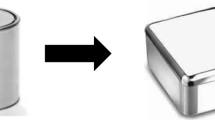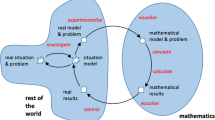Abstract
In this study, the contribution of the 3D computer modeling to the twenty-first century’s common competencies was evaluated from the perspective of secondary school students. The one-group post-test only design was used in the study. The instruments of the data collection process were an achievement test and a questionnaire developed by the researchers. The t-test and single sample chi-square test for related samples were performed to analyze the gathered data. The results of the study presented that secondary school students thought that 3D computer modeling education contributes to the lectures as mathematics, geometry, technological information, and design. Moreover, it supports the development of design, communication, collaboration, creativity, and problem-solving skills positively.
Similar content being viewed by others
References
Akıllı, M., & Seven, S. (2014). The effects of 3D computer models to academic achievement and spatial ability: Atomic models. Turkish Journal of Education, 3(1), 11–23. https://doi.org/10.19128/turje.18107
Arıcı, V. A. (2013). A study on 3d-virtual reality in science education programs: “solar system and beyond: space puzzle” unit sample (Unpublished Master Thesis). Menderes University, Department of Elementary Education, Turkey.
Azimi, P., Zhao, D., Pouzet, C., Crain, N. E., & Stephens, B. (2016). Emissions of ultrafine particles and volatile organic compounds from commercially available desktop three dimensional printers with multiple filaments. Environmental Science and Technology, 50(3), 1260–1268. https://doi.org/10.1021/acs.est.5b04983
Becker, S. A., Brown, M., Dahlstrom, E., Davis, A., DePaul, K., Diaz, V., & Pomerantz, J. (2018). NMC Horizon Report: 2018 Higher Education Edition Louisville, CO: EDUCAUSE. Retrieved from https://www.learntechlib.org/p/184633/.
Bell, S. (2010). Project-based learning for the 21st century: Skills for the future. The Clearing House. A Journal of Educational Strategies, Issues, and Ideas, 83(2), 39–43. https://doi.org/10.1080/00098650903505415
Binkley, M., Erstad, O., Hermna, J., Raizen, S., Ripley, M., Miller-Ricci, M., & Rumble, M. (2012). Defining twenty-first century skills. In P. Griffin, E. Care, & B. McGaw (Eds.), Assessment and teaching of 21st century skills (pp. 17–66). Springer.
Brown, A. (2015). 3D Printing in instructional settings: Identifying a curricular hierarchy of activities. TechTrends, 59(5), 16–24. https://doi.org/10.1007/s11528-015-0887-1
Campbell, M., Saltmarsh, S., McPherson, A., & Drew, C. (2013). Issues of teacher professional learning within ‘non-traditional’ classroom environments. Improving Schools, 16, 209–222. https://doi.org/10.1177/1365480213501057.
Cano, L. M. (2015). 3D printing: A powerful new curriculum tool for your school library. Libraries Unlimited.
Chang, Y., Chen, M. C., Chuang, M. J., & Chou, C. (2019). Improving creative self-efficacy and performance through computer-aided design application. Thinking Skills and Creativity, 31, 103–111. https://doi.org/10.1016/j.tsc.2018.11.007
Chekrouni, N., Kleipool, R. P., & Bakker, B. S. (2020). The impact of using three-dimensional digital models of human embryos in the biomedical curriculum. Annals of Anatomy—Anatomischer Anzeiger. https://doi.org/10.1016/j.aanat.2019.151430
Despeisse, M., Baumers, M., Brown, P., Charnley, F., Ford, S. J., Garmulewicz, A., Knowles, S., Minshall, T., Mortara, L., Reed-Tsochas, F., & Rowley, J. (2016). Unlocking value for a circular economy through 3D printing: A research agenda. Technological Forecasting & Social Change, Forthcoming. https://doi.org/10.1016/j.techfore.2016.09.021
Emre, Ş, Yolcu, M. B., & Celayir, S. (2018). Use of three-dimensional printed models in the training of medical students in pediatric surgery: First impressions. Çocuk Cerrahisi Dergisi, 32(2), 55–60. https://doi.org/10.5222/JTAPS.2018.055
Erkuş, A. (2003). Psikometri üzerine yazılar. Türk Psikologlar Derneği Yayınları.
Figg, C., Jennifer, R., Shannon, W., & Pelchat, K. (2018). Using Informal Learning of Makerspaces to Enhance Technological Pedagogical and Content Knowledge (TPACK). Paper presented at the Society for Information Technology & Teacher Education International Conference 2018, Washington, DC, USA.
Frank, A. (2005). What do students value in built environment education? CEBE Transactions, 2(3), 21–29. https://doi.org/10.11120/tran.2005.02030021
Gretter, S., & Yadav, A. (2016). Computational thinking and media & information literacy: An integrated approach to teaching twenty-first century skills. TechTrends, 60, 3–9. https://doi.org/10.1007/s11528-016-0098-4
Haşlaman, T., Kuşkaya, F. M., & Usluel, Y. K. (2007). The integration of information and communication technologies in learning and teaching process: A lesson plan example. Education and Science, 32(146), 54–63.
Hatchuel, A., Masson, P. L., Reich, Y., & Subrahmanian, E. (2018). Design theory: A foundation of a new paradigm for design science and engineering. Research in Engineering Design, 29(1), 5–21. https://doi.org/10.1007/s00163-017-0275-2
International Baccalaureate (IB). (2013). IB learner profile. Retrieved from https://www.ibo.org/contentassets/fd82f70643ef4086b7d3f292cc214962/learner-profile-en.pdf.
ISTE. (2016). 2016 ISTE Standards for Students. Retrieved from https://conference.iste.org/uploads/ISTE2017/HANDOUTS/KEY_108218083/2016ISTEStandardsforStudents.pdf.
Laar, E., Deursen, A. J. A. M., Dijk, J. A. G. M., & Haan, J. D. (2017). The relation between 21st-century skills and digital skills: A systematic literature review. Computers in Human Behavior, 72, 577–588. https://doi.org/10.1016/j.chb.2017.03.010
Laar, E., Deursen, A. J. A. M., Dijk, J. A. G. M., & Haan, J. D. (2019). Determinants of 21st-century digital skills: A large-scale survey among working professionals. Computers in Human Behavior, 100, 93–104. https://doi.org/10.1016/j.chb.2019.06.017
Lee, S., & Yan, J. (2016). The impact of 3D CAD interfaces on user ideation: A comparative analysis using SketchUp and Silhouette Modeler. Design Studies, 44, 52–73. https://doi.org/10.1016/j.destud.2016.02.001
Liaw, S. Y., Soh, S. L. S., Tan, K. K., Wu, L. T., Yap, J., Chow, Y. L., Lau, T. C., Lim, W. S., Tan, S. C., Choo, H., Wong, L. L., Lim, S. M., Ignacio, J., & Wong, L. F. (2019). Design and evaluation of a 3D virtual environment for collaborative learning in interprofessional team care delivery. Nurse Education Today, 82, 64–71. https://doi.org/10.1016/j.nedt.2019.06.012
Lonsdale, M., & Anderson, M. (2012). Preparing 21st century learners: The case for school community collaborations. Australian Council for Educational Research. Retrieved from https://research.acer.edu.au/policy_analysis_misc/16/.
Luan, X., **e, Y., Ying, L., & Wu, L. (2008). Research and development of 3D modeling. IJCSNS International Journal of Computer Science and Network Security., 8(1), 49–53.
Karademir, T (2018). Ecologic approach to adaption of technology: A sustainable digital learning material development ecosystem (Unpublished PhD thesis). Ankara University, Educational Science Faculty.
Kell, H. J., Lubinski, D., Benbow, C. P., & Steiger, J. H. (2013). Creativity and technical innovation: Spatial ability’s unique role. Psychological Science, 24(9), 1831–1836. https://doi.org/10.1177/0956797613478615
Kereluik, K., Mishra, P., Fahnoe, C., & Terry, L. (2013). What knowledge is of most worth: Teacher knowledge for 21st century learning. Journal of Digital Learning in Teacher Education, 29(4), 127–140.
Kostakis, V., Niaros, V., & Giotitsas, C. (2015). Open source 3D printing as a means of learning: An educational experiment in two high schools in Greece. Telematics and Informatics, 32(1), 118–128. https://doi.org/10.1016/j.tele.2014.05.001
Kuzu Demir, E. B., Çaka, C., Tugtekin, U., Demir, K., İslamoğlu, H., & Kuzu, A. (2016). The use of threen dimensional printing technologies in education: Practices in Turkey. Ege Eğitim Dergisi, 17(2), 481–503. https://doi.org/10.12984/egeefd.280754
Mitrovic, A., Milosevic, D., & Radovic, M. (2012). New approach to 3D modeling in computer graphics course. Metalurgia International., 17(11), 80–86.
National Academy of Engineering [NAE]. (2010). Standards for K-12 engineering education? The National Academies Press. https://doi.org/10.17226/12990.
NEA (National Education Association). (2010). 21st century knowledge and skills in educator preparation. Retrieved from http://www.p21.org/storage/documents/aacte_p21_whitepaper2010.pdf.
Novak, E., & Wisdom, S. (2019). Using 3D printing in science for elementary teachers. Ed Mintzes, Joel J., Walter, Emily, Active Learning in College Science. The case for evidence-based practice. Springer.
Olvera-García, E., Marín-Granados, M. D., & Ortíz-Zamora, F. J. (2019). Improving spatial abilities and comprehension in technical drawing students through the use of innovative activities and augmented reality. In F. Cavas-Martínez, B. Eynard, F. Fernández Cañavate, D. Fernández-Pacheco, P. Morer, & V. Nigrelli (Eds.), Advances on mechanics, design engineering and manufacturing II. Lecture notes in mechanical engineering. Springer.
Özabacı, N., & Olgun, A. (2011). A study on computer based science and technology education on students’ attitudes, master learning skills and achievement. Electronic Journal of Social Sciences, 10(37), 66.
Özgüven, İE. (1994). Psikolojik testler. Yeni Doğuş Matbaası.
P21 (The Partnership for 21st Century Skills). (2009). P21 framework definitions. Retrieved from http://www.p21.org/storage/documents/P21_Framework_Definitions.pdf.
Palys, T. (2008). Purposive sampling. In L. M. Given (Ed.) The Sage encyclopedia of qualitative research methods (Vol. 2). Sage.
Pantic, N., & Wubbels, T. (2010). Teacher competencies as a basis for teacher education? Views of Serbian teachers and teacher education. Teaching and Teacher Education, 26(3), 694–703. https://doi.org/10.1016/j.tate.2009.10.005
Prensky, M. (2001). Digital natives, digital immigrants, Part 2: Do they really think differently? On the Horizon, 9(6), 1–6. https://doi.org/10.1108/10748120110424843
Price, P. C., Jhangiani, R., Chiang, I. A., Leighton, D. C., & Cuttler, C. (2017). Research methods in psychology (3rd edn). Creative Commons Attribution.
Ravitz, J., Hixson, N., English, M., & Mergendoller, J. (2012). Using project based learning to teach 21st century skills: Findings from a statewide initiative. In Annual meetings of the American Educational Research Association, Vancouver, BC.
Remondino, F., & El-Hakim, S. (2006). Image-based 3D modelling: A review. The Photogrammetric Record, 21(115), 269–291. https://doi.org/10.1111/j.1477-9730.2006.00383.x
Schelly, C., Anzalone, G., Wijnen, B., & Pearce, J. M. (2015). Open-source 3-D printing technologies for education: Bringing additive manufacturing to the classroom. Journal of Visual Languages & Computing, 28, 226–237. https://doi.org/10.1016/j.jvlc.2015.01.004
Singapore Ministry of Education. (2018). 21st Century competencies. Retrieved from https://www.moe.gov.sg/education/education-system/21st-century-competencies.
Solan, J., Hamilton, L. S., & Stecher, B. M. (2013). Measuring 21st century competencies guidance for educators a global cities education network report. Retrieved from https://asiasociety.org/files/gcen-measuring21cskills.pdf.
Sönmez, S., Kesen, U., & Dalgıç, C. (2018). 3 Dimensional printers. The paper presented at 6th International Printing Technologies Symposium. İstanbul University.
Thornburg, D., Thornburg, N., & Armstrong, S. (2014). The invent to learn guide to 3D printing in the classroom: Recipes for success. Constructing Modern Knowledge Press.
Vidaurre, A. G., Hadeed, K., Retsimandresy, M., Karsenty, C., Dulac, Y., & Acar, P. (2019). Usefulness of 3D printed models of congenital heart diseases as educational tools for medical students. Archives of Cardiovascular Diseases Supplements, 11(3), 129–130. https://doi.org/10.1016/j.acvdsp.2019.04.055
Wagner, T. (2008). The Global Achievement Gap: Why even our best schools don’t teach the new survival skills our children need-and what we can do about it. Basic Books.
Wu, K., & Shah, P. (2004). Exploring visuospatial thinking in chemistry learning. Science Education, 88(3), 465–492. https://doi.org/10.1002/sce.10126
Yaman, K., Savaş, S., Güler, O., Bodukcu, H., Özçelik, Ö. F., & Açan, H. (2015). Using stereoscopic 3D visualization tehcnology in vocational education and evaluation with satisfaction scale. Presented at XVII. Academic information conference on 4–6 February, Eskişehir, Turkey. Retrieved from: t.ly/GjK3m.
Yıldız, B., & Tüzün, T. (2011). Effects of using three-dimensional virtual environments and concrete manipulatives on spatial ability. Hacettepe Üniversitesi Eğitim Fakültesi Dergisi, 41, 498–508.
Author information
Authors and Affiliations
Corresponding author
Additional information
Publisher's Note
Springer Nature remains neutral with regard to jurisdictional claims in published maps and institutional affiliations.
Rights and permissions
About this article
Cite this article
Coşkun, T.K., Deniz, G.F. The contribution of 3D computer modeling education to twenty-first century skills: self-assessment of secondary school students. Int J Technol Des Educ 32, 1553–1581 (2022). https://doi.org/10.1007/s10798-021-09660-y
Accepted:
Published:
Issue Date:
DOI: https://doi.org/10.1007/s10798-021-09660-y




